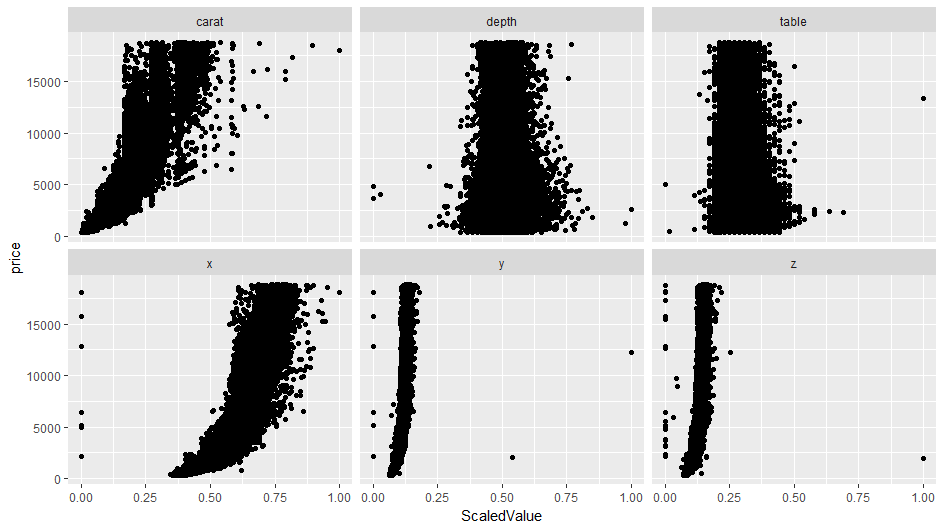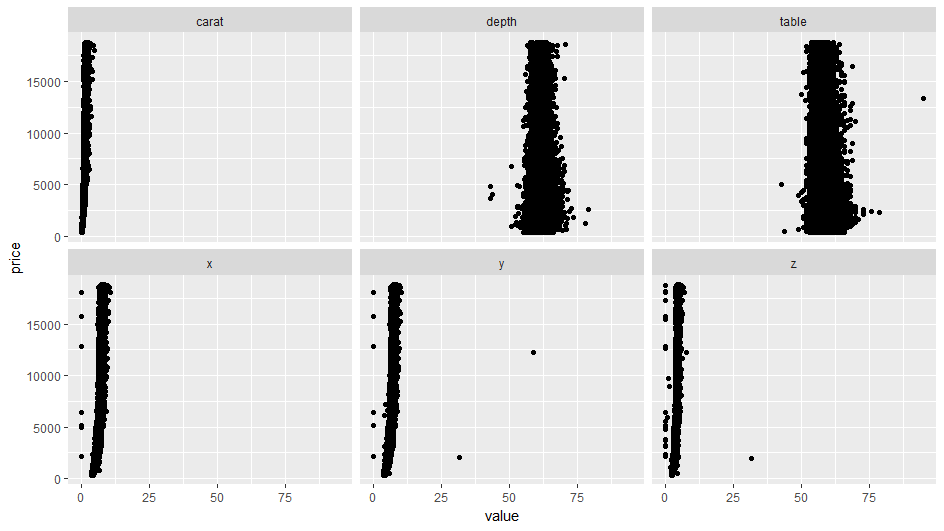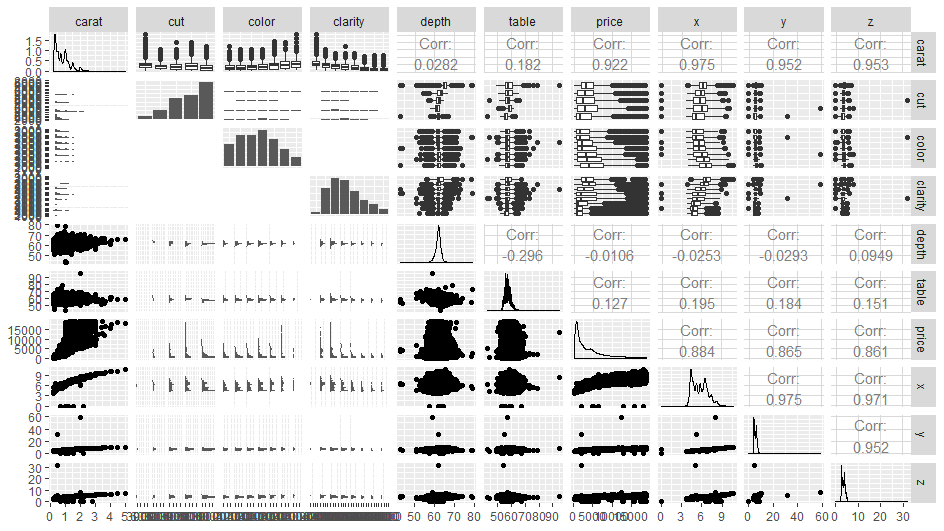データ解析をするとき、目的変数と説明変数の散布図をとりあえず描いてみることが多いと思います。
RにはGGallyパッケージにggpairs()という関数があり、これを使っている方も多いと思います。ですが、説明変数の数が増えてくると、それぞれの図が非常に小さくなり、見づらくなると思います。
※今回は説明変数が6つなので、そこまで有難みを感じにくいと思いますが。。
そこで、散布図のみを**tidyr::gather()とggplot2::facet_wrap()**を使って描く方法を紹介します。
※ggpairs()に関しては、以下のサイトが参考になると思います。
GGallyパッケージのggpair関数を使いこなすための覚え書き
今回はdiamonds データセットを用います。
library(tidyverse) #tidyverseを読み込む
df <- diamonds
df %>% head() #データの確認
# A tibble: 6 x 10
carat cut color clarity depth table price x y z
<dbl> <ord> <ord> <ord> <dbl> <dbl> <int> <dbl> <dbl> <dbl>
1 0.23 Ideal E SI2 61.5 55 326 3.95 3.98 2.43
2 0.21 Premium E SI1 59.8 61 326 3.89 3.84 2.31
3 0.23 Good E VS1 56.9 65 327 4.05 4.07 2.31
4 0.290 Premium I VS2 62.4 58 334 4.2 4.23 2.63
5 0.31 Good J SI2 63.3 58 335 4.34 4.35 2.75
6 0.24 Very Good J VVS2 62.8 57 336 3.94 3.96 2.48
df1 <-
df %>% gather(key = key,value = value,c(carat, depth,table, x, y, z)) #数値型の説明変数をgather()
df1 %>% head() #データの確認
# A tibble: 6 x 6
cut color clarity price key value
<ord> <ord> <ord> <int> <chr> <dbl>
1 Ideal E SI2 326 carat 0.23
2 Premium E SI1 326 carat 0.21
3 Good E VS1 327 carat 0.23
4 Premium I VS2 334 carat 0.290
5 Good J SI2 335 carat 0.31
6 Very Good J VVS2 336 carat 0.24
# グラフの描画
# x軸に説明変数(carat, depth,table, x, y, z)、y軸に目的変数(price)を描く
ggplot(df1)+
geom_point(aes(x=value,y=price))+
facet_wrap(~key)
このように**tidyr::gather()とggplot2::facet_wrap()**を使うと目的変数と説明変数の散布図の一覧が描けます。
しかし、この図だとx軸のスケールが共通のものとなってしまい、目的変数と説明変数の関係がわかりづらいです。
そこで、説明変数をMin-Max Normalization(正規化)してみます。正規化についてはいろいろなサイトで開設されています。
(参考)データの正規化(最大値・最小値バージョン、平均・分散バージョン)
df2 <-
df1 %>% group_by(key) %>%
mutate(ScaledValue=(value-min(value))/(max(value)-min(value))) #group_by()で指定したkeyのグループ毎に、正規化を行う
df2 %>% head() #データの確認
# A tibble: 6 x 7
# Groups: key [1]
cut color clarity price key value ScaledValue
<ord> <ord> <ord> <int> <chr> <dbl> <dbl>
1 Ideal E SI2 326 carat 0.23 0.00624
2 Premium E SI1 326 carat 0.21 0.00208
3 Good E VS1 327 carat 0.23 0.00624
4 Premium I VS2 334 carat 0.290 0.0187
5 Good J SI2 335 carat 0.31 0.0229
6 Very Good J VVS2 336 carat 0.24 0.00832
group_by()でグループ化した後の関数の挙動については以下の記事が参考になります。
dplyrでdoして楽をする
dplyrのsummarise, doの使い分けについてのメモ
例えば、以下のコードで、keyのグループの先頭2行ずつを見ることができます。
df2 %>% do(head(.,2))
# A tibble: 12 x 7
# Groups: key [6]
cut color clarity price key value ScaledValue
<ord> <ord> <ord> <int> <chr> <dbl> <dbl>
1 Ideal E SI2 326 carat 0.23 0.00624
2 Premium E SI1 326 carat 0.21 0.00208
3 Ideal E SI2 326 depth 61.5 0.514
4 Premium E SI1 326 depth 59.8 0.467
5 Ideal E SI2 326 table 55 0.231
6 Premium E SI1 326 table 61 0.346
7 Ideal E SI2 326 x 3.95 0.368
8 Premium E SI1 326 x 3.89 0.362
9 Ideal E SI2 326 y 3.98 0.0676
10 Premium E SI1 326 y 3.84 0.0652
11 Ideal E SI2 326 z 2.43 0.0764
12 Premium E SI1 326 z 2.31 0.0726
ggplot(df2)+
geom_point(aes(x=ScaledValue,y=price))+
facet_wrap(~key)
目的変数を正規化することで、それぞれの説明変数と目的変数の関係が見やすくなりました。

ちなみに、ggpairs()を今回のデータセットに用いると、以下のような出力が得られます。
library(GGally)
ggpairs(df)

